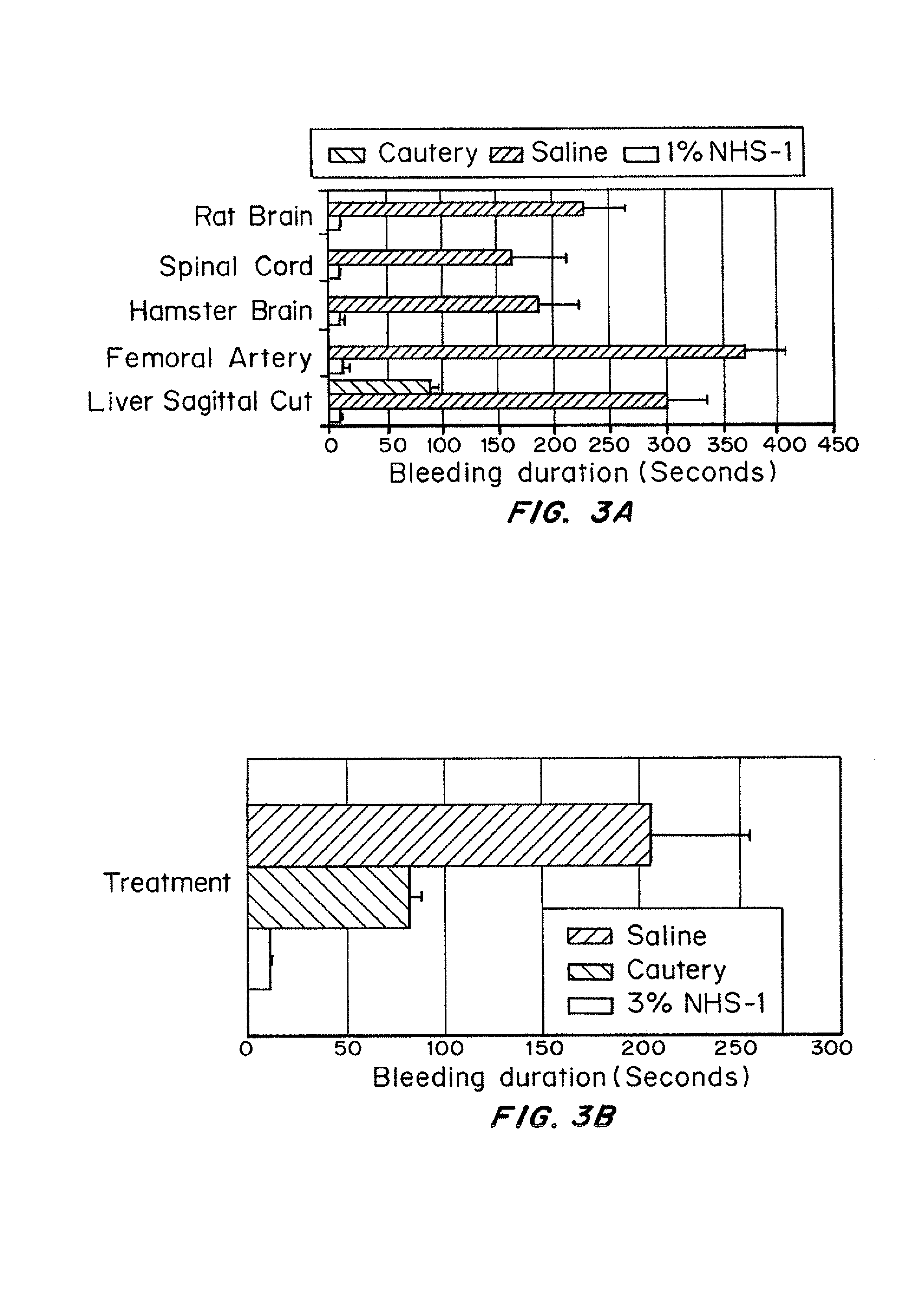Treatment of leaky or damaged tight junctions and enhancing extracellular matrix
a tight junction, leaky or damaged technology, applied in the field of treatment, can solve the problems of loss of blood pressure, organ dysfunction or failure, death, global tissue hypoxia, etc., and achieve the effect of enhancing growth and repair of surrounding tissues
- Summary
- Abstract
- Description
- Claims
- Application Information
AI Technical Summary
Benefits of technology
Problems solved by technology
Method used
Image
Examples
example 1
Hemostasis in a Brain Injury
Methods and Materials
[0182]Adult Syrian hamsters were anesthetized with an intraperitoneal injection of sodium pentobarbital (50 mg / kg) and adult rats were anesthetized with an intraperitoneal injection of ketamine (50 mg / kg). The experimental procedures adhered strictly to the protocol approved by the Department of Health and endorsed by the Committee on the Use of Laboratory Animals for Teaching and Research of the University of Hong Kong and the Massachusetts Institute of Technology Committee on Animal Care.
[0183]The animals were fitted in a head holder. The left lateral part of the cortex was exposed. Each animal received a transection of a blood vessel leading to the superior sagittal sinus (FIG. 4a). With the aid of a sterile glass micropipette, 20 μl of 1% NHS-1 solution was applied to the site of injury or iced saline in the control cases. The animals were allowed to survive for up to six months.
Results
[0184]Initial experiments in the brain includ...
example 2
Hemostasis in a Spinal Cord Injury
Methods and Materials
[0186]Under an operating microscope, the second thoracic spinal cord segment (T2) was identified before performing a dorsal laminectomy in anesthetized adult rats. After opening the dura mater, a right hemisection was performed using a ceramic knife. Immediately after the cord hemisection 20 μl of 1% solution of RADA16-I (SEQ ID NO: 60) (NHS-1) was applied to the area of the cut for bleeding control. The controls received a saline treatment. The animals were allowed to survive for up to 8 weeks as part of another experiment.
Results
[0187]The spinal environment and the brain environment were investigated for similarities or differences. Secondary damage caused by surgery can be reduced by quickly bringing bleeding under control. After laminectomy and removal of the dura, the spinal cord was hemisected at T2, from the dorsal to ventral aspect and treated (N=5) with 20 μl of 1% NHS-1. Hemostasis was achieved in 7.6 seconds. In the s...
example 3
Hemostasis in a High Pressure Femoral Artery Wound
Methods and Materials
[0188]Rats were placed on their backs and the hind limb was extended to expose the medial aspect of the thigh (FIG. 4b). The skin was removed and the overlying muscles were cut to expose the femoral artery and sciatic nerve. The femoral artery was cut to produce a high pressure bleeder. With a 27 gauge needle, 200 μl of 1% RADA16-I (SEQ ID NO: 60) (NHS-1) solution was applied over the site of injury. In two cases powder was applied to the injury site which also worked. (Data not shown and was not included in the analysis). Controls were treated with a combination of saline and pressure with a gauge. All animals were sacrificed four hours after the experiment.
Results
[0189]The femoral artery of 14 adult rats was surgically exposed, transected and then treated with 200 μl of 1% solution of NHS-1 or iced saline and packing. The treated cases (n=10) took about 10 seconds to achieve hemostasis (FIG. 3a). The controls (...
PUM
| Property | Measurement | Unit |
|---|---|---|
| size | aaaaa | aaaaa |
| distance | aaaaa | aaaaa |
| distance | aaaaa | aaaaa |
Abstract
Description
Claims
Application Information
 Login to View More
Login to View More - R&D
- Intellectual Property
- Life Sciences
- Materials
- Tech Scout
- Unparalleled Data Quality
- Higher Quality Content
- 60% Fewer Hallucinations
Browse by: Latest US Patents, China's latest patents, Technical Efficacy Thesaurus, Application Domain, Technology Topic, Popular Technical Reports.
© 2025 PatSnap. All rights reserved.Legal|Privacy policy|Modern Slavery Act Transparency Statement|Sitemap|About US| Contact US: help@patsnap.com



